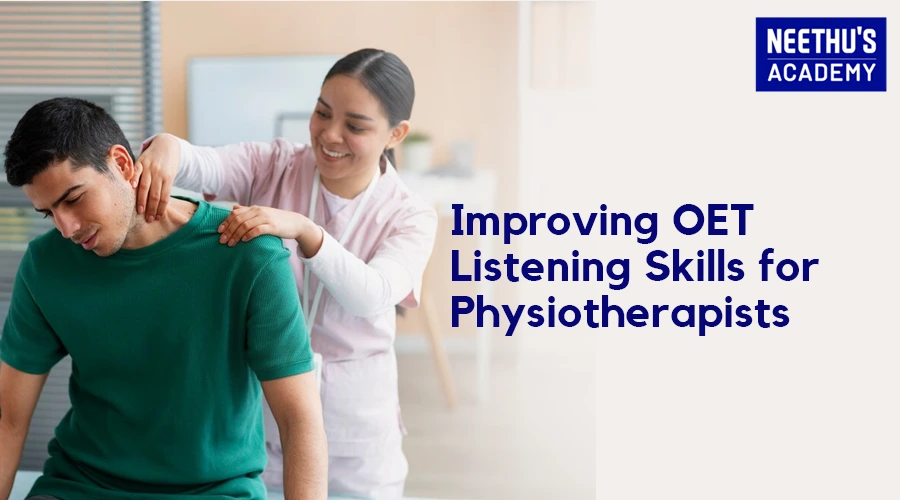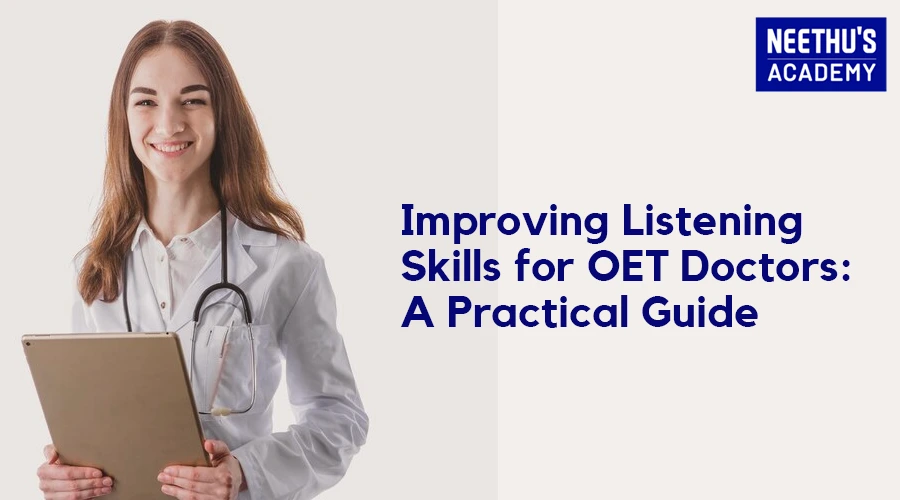OET Speaking Tips: Strategies to Ace Your Speaking Test
Effective communication in a globalized healthcare environment is as important as clinical expertise. The Occupational English Test Speaking sub-test aims to assess your ability to communicate with patients, families, and colleagues in actual medicine medical situations. As a healthcare provider, one needs to know only medical terms or procedures; you also have to tell complex information clearly and compassionately, as well as in keeping with the individual patient’s requirements.
Whether you are a nurse, doctor, or any other medical professional, acing the OET Speaking Test would boost your job prospects steeply as you can confidently practice in an English-speaking country. Below, we have broken down everything you should know about the format of the test and mastering role-play scenarios. Along the way, you will learn all the key strategies for OET speaking, find the most important resources, and get some practical tips to do well in this exam section. Let’s get you one step closer to your healthcare dream!
Understanding the OET Speaking Test Format
OET speaking test is also designed in a way that it closely mimics real life-that is, interactions in the healthcare setting. This is to test whether you can act professionally toward the patients and their families while being compassionate. Be it a nurse, a physician, a pharmacist, or any other medical professional, the attention always focuses on proper care through effective communication.
Sample Role-Play Scenarios
There are two role-play scenarios, each approximately five minutes long. In this sub-test, you will play the role of a health professional and the examiner will play the role of a patient, carer, or family member. For each scenario, you are given a scenario card. Here you are told about the patient’s condition and actions to be taken.
For example:
- The nurse may be required to explain post-surgical wound care or reassure an anxious patient.
- Doctors could be consulted to present their treatment options or to answer some of the side-effect questions of patients.
Focus on Profession-Specific Tasks
There is another aspect of OET that makes it unique. It is designed to focus on the tasks relevant to your profession. For pharmacists, this entails dealing with consultations, discussing treatment plans, handling prescriptions, and communicating with both patients and other health providers. The writing and speaking sections are heavily tailored to situations you would encounter in the day-to-day operations of a pharmacy, so the test is generally more closely related to your practice.
Duration and Assessment Criteria
The OET speaking test takes around 20 minutes. This is how it’s divided:
Warm-up conversation: You will have a small, informal conversation with the examiner on a topic of your profession.
Role-Plays: The two role-play scenarios will follow the warm-up. You will be given 2-3 minutes to prepare for each role-play using the scenario card.
OET Speaking Criteria
Linguistic criteria
Intelligibility: The ease with which the listener can understand you.
Fluency: The capacity to speak freely with fewer pauses.
Appropriate Language Usage: Use appropriate professional and non-technical language.
Resources of Grammar and Expression: Your stock of grammatical patterns and vocabulary.
Clinical communication criteria
Relationship building: How well you make the patient comfortable.
Understanding and incorporating information: How well you gather information and address the patient’s concerns.
Providing structure: How well you guide the interaction and how structured your responses will be.
Information-giving: How clear and concise the information/medical terms you impart to the patient are.
Empathy: Your capacity to display empathy and to reassure.
Key Tips to Ace the OET Speaking Test
Know Your Role-Play Format
Familiarize yourself with the role-play framework. You will be given a scenario card telling you about the patient’s issue and what you are to do for him, including obtaining information, discussing a treatment, or reassuring him. Be sure to take note of the instructions on what to do during the role-play.
Tip: Do not try to do it all at once. Prioritize the most important tasks and deal with those that concern your patient the most first.
Practice Active Listening
Active listening is the most crucial aspect in any communication based on healthcare. Make sure you’re not just mechanically responding but that you’re engaging with the patient’s concerns. Start asking follow-up questions, clarifying details and making sure you understand them properly before you move ahead.
Tip: Use phrases such as “I see, could you tell me more about that?” or “Let me make sure I have understood you correctly…”.
Focus on Clarity and Fluency
Clarity and fluency are highly valued in the OET. Speak clearly and at a reasonable pace so that your patient will understand you. Do not speak too fast or too slow; it may sound unnatural to the conversation.
Tip: Record yourself practicing role-plays and listen for areas where you could improve your fluency.
Stay Professional Yet Empathetic
In the OET Speaking Test, your ability to balance professionalism with empathy is vital. Use formal but friendly language and always take pains to concern yourself with the patient’s condition.
Tip: Reassuring phrases like “I understand this is a difficult time for you” or “I’m here to help you through this” show empathy without compromising professional tenor.
Manage Time Effectively
Time management is important in the role play scenarios. You only have 5 minutes per scenario so use them correctly. Pay attention to what the key tasks of a particular scenario card are and do not let yourself be led astray on tangents. You would want to cover all your points within that time frame.
Tip: Do timed role-plays to get accustomed to doing things within 5 minutes and not feel like you are running out of it.
Practice Role-Play Scenarios
In preparation for these role-plays, adhere to the following for each scenario:
Greet the patient: Set up a warm, professional relationship.
Ask appropriate questions: Obtain the necessary information for the condition or concern about the patient.
Provide helpful guidance or recommendations: Give clear, simple information, depending on the situation, detailing or reassuring.
Reassure and check understanding: Ask the patient if they understand your advice, using questions like “Does that sound okay to you?
Avoid Common Mistakes in OET Speaking
Speaking too fast or too slowly
Speaking too quickly for the OET Speaking Test could confuse the patient, and speaking too slowly may seem unnatural or break the rhythm of the conversation. The flow can improve further and give a clearer understanding by finding the balance in a steady, moderate pace. To achieve this, record your role-play practice and listen to it afterwards. Through this, you will be able to listen to how you sound. You will find such areas in which you should regulate your speed and make improvement in that area. If you maintain the pace of delivery with precision, not only do you understand it well, but during the test, you will appear confident and professional.
Using medical jargon without explanation
Technical terms often cause confusion where the patients are not very familiar with them. So, in the OET Speaking Test, use layman’s terms as much as you can. If you must use technical terms, then ensure that usage is clear. For example, instead of “hypertension,” you would say “high blood pressure.” This way, not only do you create more understanding, but you also create trust with your patients.
Failing to check the patient’s understanding
Failure to elicit the patient’s reaction to whether he or she understands your advice forms one of the most common causes of communication failures when sitting the OET Speaking Test. It is therefore essential that you engage the patient by ensuring that he or she understands. To achieve this, you may ask, “Does that make sense?” or “Would you like me to explain that further?”. This approach improves understanding and shows dedication to effective communication and patient-centered care, which are two of the most significant criteria in the assessment. Additionally, making sure you take time to check for understanding increases the supportive nature of the environment for the patient.
Final thoughts
Mastering the OET speaking test involves language competencies, professional communication, and empathy. Following these OET speaking tips and doing practice exercises from OET speaking materials will help in acing an exam. Recall clear communication and patient-centered competency for success. With proper preparation and coaching, such as by taking admissions in a good OET academy, you can go on to confidently sit for the test and achieve the desired marks.
Frequently Asked Questions





